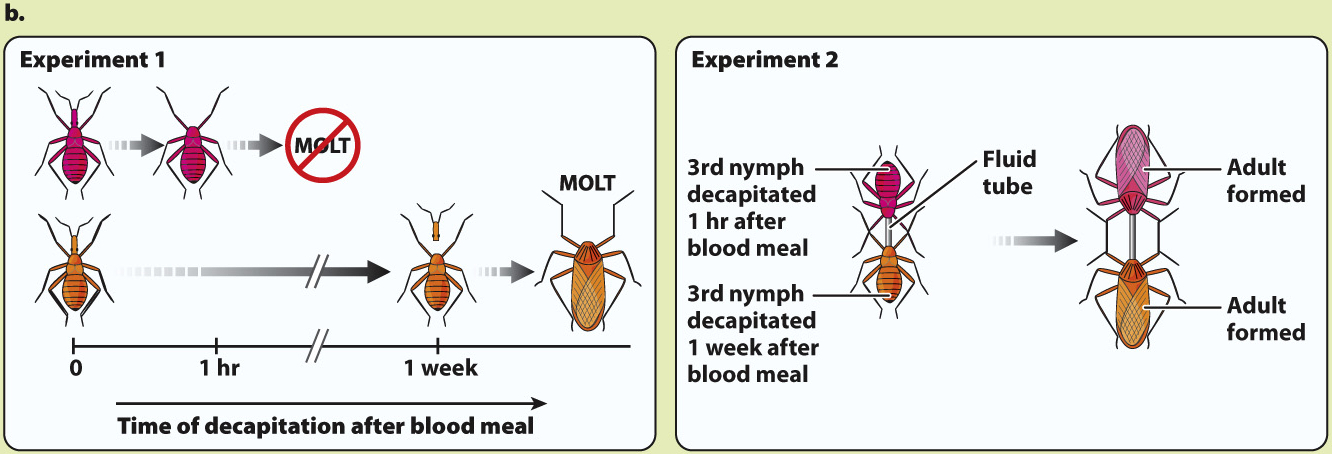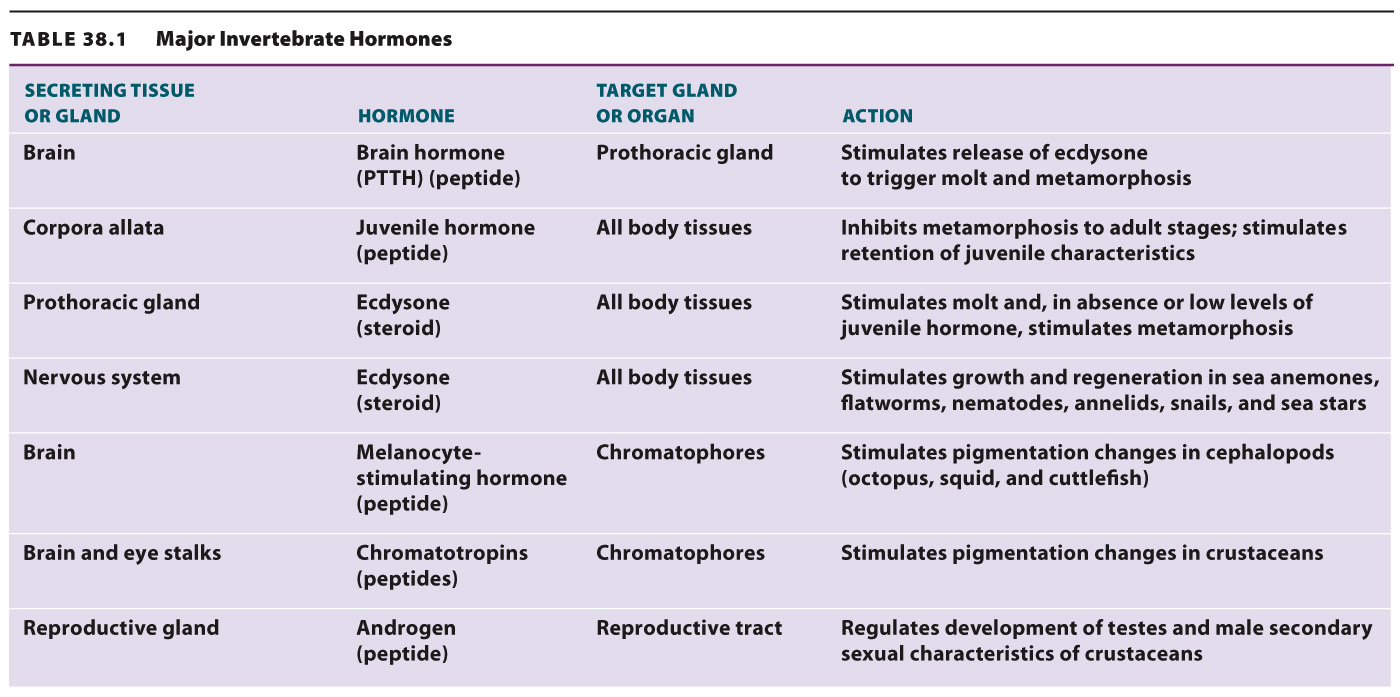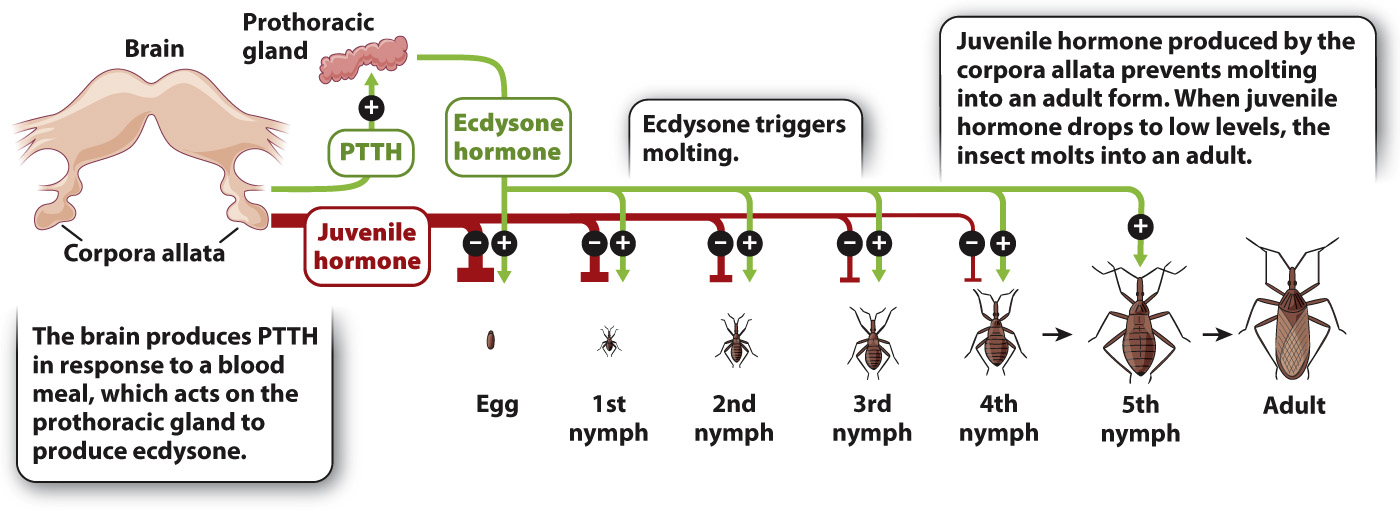The endocrine system regulates growth and development.
Growth and development require broad changes in many different organ systems. The release of circulating hormones from the endocrine system accomplishes these changes, regulating how animals develop and grow. For example, we discuss in Chapter 42 the importance of the sex hormones estrogen and testosterone in determining female or male sexual characteristics both in the embryo and during puberty.
As another example, let’s consider how the well-

Molting and metamorphosis are regulated by hormones released from tissues in the insect’s head. British physiologist Vincent Wigglesworth studied their effects on the blood-
HOW DO WE KNOW?
FIG. 38.2
How are growth and development controlled in insects?
BACKGROUND During the 1930s, British physiologist Vincent Wigglesworth studied how a blood meal taken by the bug Rhodnius triggered its molting and growth. This work pioneered the discovery of hormonal substances that stimulated its growth. Rhodnius goes through five successive larval stages (called nymphs) before becoming a winged adult, as shown in Figure 38.2a. Each developmental step is triggered by a blood meal.

HYPOTHESIS Wigglesworth hypothesized that a substance (specifically, a hormone) that diffuses from the head triggers molt in Rhodnius.
EXPERIMENT Wigglesworth decapitated juvenile bugs at different intervals of time after a blood meal and observed whether or not molting occurred. (Decapitation does not kill the insect.)

RESULTS Wigglesworth showed that if a bug is decapitated less than an hour after a blood meal, it fails to molt. If a bug is decapitated 1 week after the blood meal, it molts (Fig. 38.2b, Experiment 1). He also found that if he used a fluid tube to join the body of a bug decapitated immediately after a blood meal with the body of one that wasn’t decapitated until a week after feeding, the bodies of both bugs molted (Fig. 38.2b, Experiment 2). This experiment demonstrated that the diffusing hormone could trigger molting in the bug that lacked the hormone because of immediate decapitations.
CONCLUSION A substance diffuses from the head in Rhodnius and triggers the molting process.
FOLLOW-
SOURCES Wigglesworth, V. B. 1934. “The Physiology of Ecdysis in Rhodnius prolixus (Hemiptera). II. Factors Controlling Moulting and ‘Metamorphosis.’” Quarterly Journal of Microscopical Sciences 77:191–
The German endocrinologist Alfred Kuhn found a similar result in experiments performed on moth caterpillars. Tying the caterpillar’s head off from the rest of the body prevented the body from molting. Wigglesworth and Kuhn considered the diffusing substance to be a brain hormone. Subsequent work showed that cells in a specialized region of the insect brain secrete the peptide now known as prothoracicotropic hormone (PTTH) (Table 38.1). In Rhodnius, PTTH is released after a blood meal and acts to trigger the animal’s molt by stimulating the release of a second hormone from the prothoracic gland.

Two decades later, the German endocrinologist Peter Karlson isolated and purified this second hormone, termed ecdysone. PTTH triggers molting by stimulating the release of ecdysone, a steroid hormone that coordinates the growth and reorganization of body tissues during a molt. The action of ecdysone is a good example of how a hormone can precisely coordinate broad changes in body organization and function, in contrast to the specific regulation that nerves provide. Karlson was able to purify a small amount of ecdysone from large numbers of silk moth Bombyx caterpillars. He ultimately isolated a mere 25-
In his studies of Rhodnius, Wigglesworth also noted that, whatever the larval stage, the decapitated bug always molted into an adult after its blood meal. By removing just the front brain region of the head, Wigglesworth was able to show that a region in the head close to the brain releases a hormone that normally prevents the earlier larval stages from molting into the adult form (Table 38.1). This hormone, called juvenile hormone, is released in decreasing amounts during each successive larval molt. After the fifth and final stage, the level of juvenile hormone is so low that it no longer blocks maturation, and at the final molt the insect undergoes its final growth into the adult form (Fig. 38.3).

The brains of insects, similar to the nervous systems of other invertebrate and vertebrate animals, contain neurosecretory cells. These cells are neurons that release hormones, which act on endocrine glands or other targets within the insect instead of secreting neurotransmitters that bind to another neuron or to muscle. In the case of insects, peptide hormones released from neurosecretory brain cells act on the corpora allata (paired endocrine glands in insects) and the prothoracic gland (Fig. 38.3).Neurosecretory cells stimulate the corpora allata to produce juvenile hormone so that molting larvae retain juvenile characteristics. At appropriate times, other neurosecretory brain cells secrete the peptide hormone PTTH, which stimulates the release of ecdysone from the prothoracic gland, triggering the transition from larval to pupal and adult forms.
These studies reveal how small amounts of hormones released from key glands within the animal’s body regulate major stages of growth and changes in body form during metamorphosis. When an animal’s body requires coordinated changes in multiple organ systems, hormonal regulation by the endocrine system plays a critical role.
Hormones also regulate growth in humans and other vertebrate animals. Growth hormone controls the growth of the skeleton and many other tissues in the human body. Growth hormone is produced by the pituitary gland, which is located beneath the brain. Tumors of the pituitary that cause an overproduction of growth hormone lead to gigantism, and tumors that result in too little growth hormone cause pituitary dwarfism. The role of the pituitary gland in regulating body function is described later in the chapter.